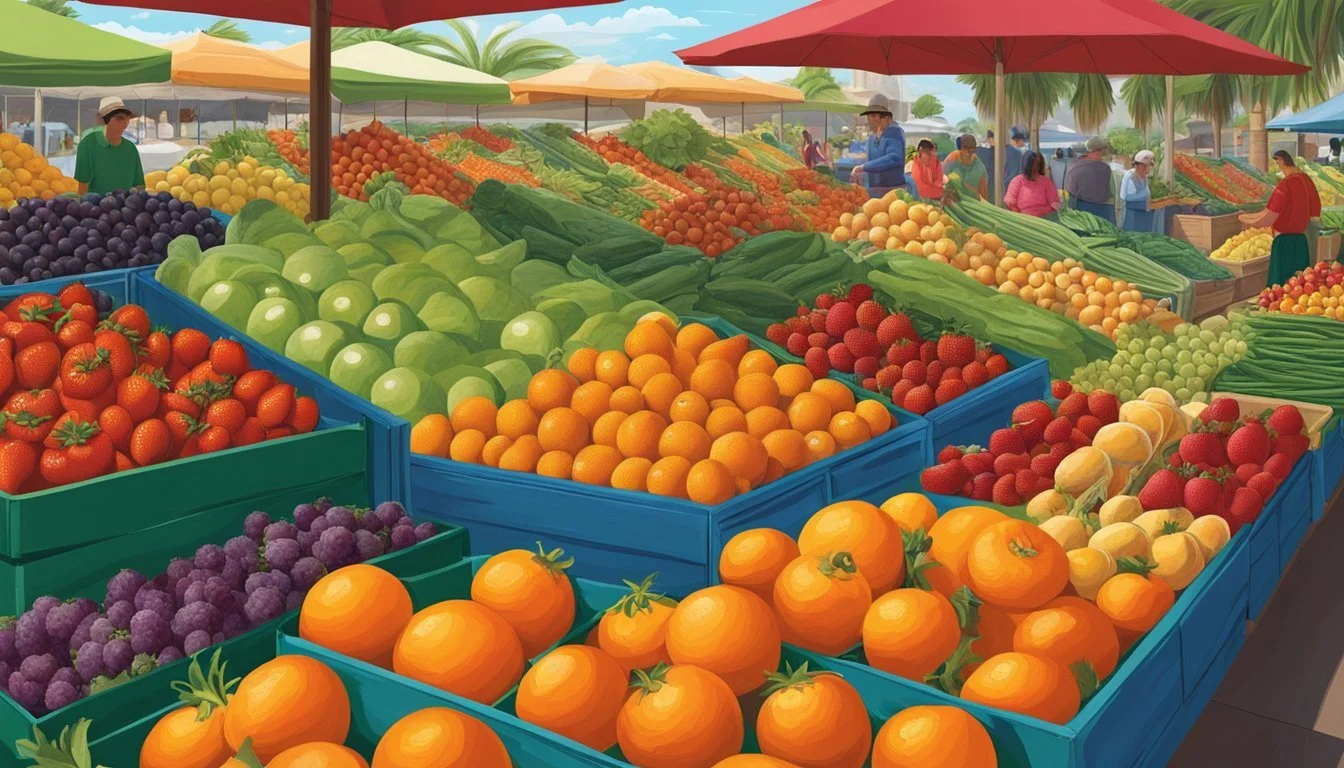Florida Seasonal Fruit & Vegetables in April
A Guide to Fresh Produce
This Article is Part of our Florida Seasonal Fruit & Veg Calendar
April in Florida is a vibrant time for fruit (What wine goes well with fruit?) and vegetable enthusiasts. The state's unique climate allows for a rich variety of produce to thrive, offering a bountiful selection that peaks in freshness and flavor during this month. The subtropical conditions, frequent rains, and warm temperatures create an ideal environment for a diverse cultivation of crops.
Seasonal produce not only tastes better but also packs a higher nutritional content and supports local farming communities. Florida's April harvest includes a delightful array of fruits like blueberries, which are at their juiciest. The soil and weather conditions during this time contribute to the optimal growth of these berries, making them a local favorite.
On the vegetable front, Florida’s soil yields a plentiful supply of fresh greens and other vegetables. Broccoli (how long does broccoli last?), celery (how long does celery last?), and cabbage are just a few examples of the vegetables that are harvested during this period. Their crisp and fresh flavors are indicative of the produce that has been grown and picked at the right time, underscoring the importance of seasonal eating.
Seasonal Fruits Overview
Florida in April is abundant with a variety of fruits reaching their peak season. Shoppers can expect to find an array of fresh, flavorful options that are particularly distinct to this region and season.
Citrus Fruits
In April, citrus fruits are transitioning, yet consumers can still enjoy the tail end of the season with several varieties available:
Oranges: Valencia oranges are especially juicy and perfect for juicing.
Grapefruit: This tart and tangy fruit remains in season, retaining its juiciness and vibrant flavor.
Tangerines: Offering a burst of sweetness, these are often nearing the end of their season.
Limes: Still available, limes add a fresh zest to dishes and drinks.
Berries
The berry season highlights two popular fruits known for their sweet and tangy flavors:
Strawberries: Starting to wane but still available, strawberries from Florida are known for their sweetness.
Blueberries: April signifies the start of the blueberry season, bringing with it berries that are plump and bursting with flavor.
Melons
As April ushers in warmer weather, melon varieties become more prominent:
Watermelons: The quintessential summer fruit starts to become available, offering refreshing hydration and sweetness.
Italicized note: Other melon types may be available but are not at their peak until summer.
Tropical Fruits
Tropical fruits begin to come into season, providing exotic flavors:
Papaya: This tropical fruit continues to be available, ripe with a sweet, musky flavor.
Mangoes: The beginning of the mango season offers a tropical sweetness that is highly anticipated.
Carambola (Star Fruit): With its distinct shape and refreshing taste, carambola can also be found.
Stone Fruits
While not traditionally at their peak until later in the year, certain stone fruits start to become available:
Peaches: A few early varieties may start to appear in markets, hinting at the bounty of stone fruits to come.
Seasonal Vegetables Guide
In Florida, April is a prime month for harvesting a diverse array of vegetables. From crisp leafy greens to robust root vegetables, this guide will help consumers identify what fresh produce is in season.
Leafy Greens
Lettuce: Available and ideal for salads and sandwiches.
Spinach: Fresh spinach is perfect for salads, sautés, and smoothies.
Collard Greens: These greens are excellent for slow-cooked dishes.
Root Vegetables
Carrots (how long do carrots last?): Fresh and sweet, great for snacking, roasting, or adding to salads.
Radishes: Crunchy and peppery, suitable for salads and garnishes.
Potatoes: Versatile for a variety of cooking methods; boiling, mashing, or baking.
Nightshades
Eggplant (What wine goes well with eggplant?): Fresh eggplant is ideal for grilling, baking, or frying.
Tomatoes: Vine-ripened and perfect for salads, sandwiches, or sauces.
Legumes and Beans
Peas: Fresh peas can be used in salads, soups, or as a side dish.
Miscellaneous Vegetables
Broccoli: This cruciferous vegetable is great for steaming, roasting or stir-frying.
Mushrooms: Ideal for adding a savory flavor to any dish.
Celery: Crisp and perfect for salads, soups, or as a healthy snack.
Cucumbers: Fresh cucumbers are hydrating and ideal for salads.
Onions: A staple for flavoring a wide array of dishes.
Squash/Zucchini: These versatile vegetables are great for sautéing, grilling, or baking.
Eating With the Seasons
In April, Florida becomes a bountiful source of fresh produce. Local farmers harvest a variety of fruits and vegetables that are at their prime during this month. Seasonal eating not only offers the freshest flavors but also supports regional agriculture and minimizes the environmental impact of long-distance transportation.
Seasonal Fruits: Florida's warm climate favors the early ripening of certain fruits:
Blueberries: A berry lover's delight, offering a burst of flavor and nutrients.
Cantaloupes (how long does cantaloupe last?): Juicy and rich in vitamins, perfect for a refreshing snack.
Seasonal Vegetables: April also sees the harvest of various vegetables:
Broccoli and Cauliflower: Both rich in fiber; they are staples in seasonal cooking for their versatility.
Celery and Carrots: Crunchy and nutritious, these root vegetables are ideal for both raw and cooked dishes.
Here's a quick glance at what's fresh in April:
Fruits Vegetables Blueberries Broccoli Cantaloupes Brussels sprouts Cabbage Carrots Cauliflower Celery
The seasonal harvest offers a palate that encourages creativity in the kitchen. Chefs and home cooks alike can take advantage of the abundance of fresh ingredients to create dishes that are both vibrant and flavorful. By choosing locally sourced, in-season produce, consumers can enjoy the taste of freshness while contributing to their community's sustainability.
Florida's Growing Season
Florida offers a unique growing environment, allowing for a diverse range of fruits and vegetables to flourish. The Sunshine State takes advantage of a year-round growing season, varying across regions. Here is a breakdown of the seasonal harvest calendar for Florida.
Spring Harvest
In spring, Florida's warm climate is excellent for producing a variety of vegetables and fruits. Asparagus begins to peak, alongside fava beans (how long do fava beans last?) and greens such as lettuce and spinach. Cantaloupe also starts to ripen, adding a sweet touch to the seasonal selection. Gardeners and farmers plant green beans and squash, which are ready to harvest soon due to the state's subtropical conditions.
Summertime Crops
As summer arrives, the longer days and consistent sunlight contribute to the growth of a vast array of produce. Corn and peppers thrive in the heat, while okra becomes a staple in gardens. Beans continue their growth, and squash varieties enjoy the warm soil, now ready to be picked. This season is also a prime time for fennel (how long does fennel last?), benefiting from the balmy nights.
Fall Harvest
With the arrival of fall, the focus shifts to crops that can endure the slightly cooler temperatures. Leeks and a fresh batch of greens are sown, taking advantage of the milder weather. Pumpkins and gourds start to mature, coloring the fields with their vibrant hues. It's also a transitional period for cabbage and a renewed opportunity for planting green beans for a continued harvest.
Winter Crops
In winter, while the rest of the country slows down on growing, Florida's milder climate supports the cultivation of several hardy vegetables. Cooler nights and moderate daytime temperatures make it ideal for growing cabbage and cantaloupe. Beans persevere through the cold snaps, and greens can still be produced in the temperate winter weather.
Health Benefits of Seasonal Eating
Eating seasonally offers numerous health advantages. Fruits and vegetables picked during their peak season tend to be richer in nutrients compared to those harvested out of season. This is because produce harvested at its peak generally has had more sun exposure, leading to higher levels of antioxidants such as vitamin C and flavonoids.
Benefits include:
Enhanced Nutrient Intake: Seasonal produce typically arrives soon after harvest, which means it retains more nutrients. For example, vitamin C, prevalent in citrus fruits, can degrade over time when stored.
Dietary variety: Rotating fruits and vegetables in the diet not only adds different flavors but also introduces a wider range of nutrients and fiber to one's diet. This diversity supports a healthy diet and can contribute to the maintenance of gut health.
Freshness and flavor: Seasonal eating ensures that consumers get the freshest possible produce, often with exceptional taste compared to non-seasonal items which may have traveled long distances and been stored for extended periods.
Nutrient Contents of Some Seasonal Foods in April in Florida:
Food Item Key Nutrients Blueberries Vitamin C, Vitamin K, Manganese, Fiber Broccoli Vitamin C, Vitamin K, Iron, Fiber Cabbage Vitamin C, Vitamin K, Folate, Fiber Carrots Vitamin A, Vitamins B, Vitamin K, Fiber Celery Vitamin A, Vitamin C, Vitamin K, Fiber
Incorporating these foods into meals during their peak season can be a cornerstone of a healthy diet, ensuring a person reaps all possible health benefits associated with fresh, nutrient-dense produce.
Recipes and Preparation
April in Florida marks the availability of a variety of fresh produce, offering a plethora of opportunities for culinary exploration. This section provides specific recipes and methods tailored for seasonal fruits and vegetables that elevate their natural flavors.
Salads and Wraps
For a vibrant salad, combining leafy greens with slices of juicy cantaloupes and a citrus dressing can make for a refreshing dish. Alternatively, wraps filled with thinly sliced carrots, cabbage, and fresh herbs (how long do fresh herbs last?) provide a satisfying crunch and nutrients in a handheld meal.
Soups and Stews
Utilizing the season's produce, such as tomatoes and bell peppers which are ripe for the picking, one can prepare a hearty stew. A blend of broccoli, cauliflower, and carrots, simmered with fresh herbs, serves as a comforting soup option.
Grilled and Roasted
Grilled options emerge as a favorite; zesty grilled blueberries can act as a unique side or a dessert topping. Roasted root vegetables, such as sweet potatoes and beets, drizzled with a bit of olive oil and sea salt (how long does sea salt last?), make for satisfying side dishes.
Sides and Snacks
For a quick side or snack, one can't go wrong with celery sticks dipped in homemade hummus or peanut butter. Additionally, fresh vegetable chips made from sliced beets or sweet potatoes offer a healthier alternative to store-bought snacks.
Supporting Florida Agriculture
In April, consumers have the opportunity to directly support Florida agriculture and boost the local economy by choosing fresh, locally-grown produce. By purchasing fruits and vegetables that are in season, consumers not only enjoy peak freshness and nutritional value but also help sustain the livelihood of Florida farmers.
Florida Department of Agriculture and Consumer Services (FDACS) reinforces this initiative through its various consumer education programs, highlighting the abundance of produce available during the spring months in Florida. The department actively promotes the "Fresh From Florida" campaign, ensuring consumers can easily identify Florida-grown products on the market.
To better support Florida agriculture, consumers can refer to the FDACS's availability charts, which provide valuable information on seasonal produce. For the month of April, a variety of fruits and vegetables reach their optimal harvest time, including:
Vegetables: Tomatoes, Cucumbers, Bell Peppers, Sweet Corn
Fruits: Blueberries, Strawberries, Watermelon
By choosing these locally-sourced items, consumers contribute to the state's agricultural economy and receive the benefits of freshness. Additionally, many local restaurants are joining the movement by incorporating "farm fresh" ingredients into their menus, a testament to the growing popularity of supporting Florida producers.
One can further contribute by attending local farmer's markets or joining community-supported agriculture programs (CSAs), where Florida's rich agricultural bounty is on full display. Through these actions, consumers play a vital role in sustaining the state's agricultural heritage and ensuring the prosperity of its farmers.
Shopping Tips for Consumers
When consumers shop for produce in April, it's essential to consider the bounty of seasonal fruits and vegetables that Florida offers. The seasonal produce boasts not only better flavor but often comes at a better price and supports local farmers.
Identify Seasonal Produce: Look for signs indicating "Fresh from Florida" to ensure buying in-season, local goods.
Ask Vendors: Don't hesitate to strike up a conversation with market vendors. They can provide valuable information about the produce, such as the origin and the best ways to enjoy it.
Seasonal Availability Table:
Fruit/Vegetable Available Blueberries April - June Broccoli Until May Cabbage Until June Carrots Until June
Consumers should also:
Check for Freshness: Fresh produce should look vibrant in color and firm to the touch.
Plan Meals Ahead: Knowing what's in season helps plan meals around the freshest ingredients.
Supporting Local: Buying from local stores and farmers markets not only aids the local economy but also ensures the produce is at its peak freshness.
Purchasers embracing these habits will find them rewarded with produce that reflects the true taste of the season, supports local economy, and sustains the environment.
Understanding the Seasonal Calendar
The seasonal calendar guides consumers on what to expect during specific months, ensuring fresh and locally grown fruits and vegetables are at the peak of their flavor and nutritional value.
April Produce
In April, Florida's agricultural landscape is abundant with a variety of fresh produce. Consumers can enjoy a selection of fruits and vegetables that are typically at their peak during this month. For fruits, blueberries are a highlight, having just entered their prime season which will last through May.
Vegetables available in April include:
Bell peppers
Celery
Cucumbers
Tomatoes
Squash
Additionally, shoppers can find other commodities like:
Eggplant
Sweet corn
Oranges
Strawberries
What's Next in May?
As Florida transitions into May, there's an anticipation for the arrival of new produce while some of April's offerings continue to thrive. For example, blueberries, while having hit their peak in April, are still available fresh and flavorful in May. Vegetables like broccoli and cabbage, which have been in season since as early as October and November, are still available until the end of May. Upcoming seasonal items to look forward to in May include:
Cantaloupes
Watermelons
This continuation and arrival of fresh produce offer an opportunity for consumers to plan their menus around the freshest ingredients available.
Exploring Florida's Markets
As April ushers in, Florida's markets become vibrant with an array of fresh produce. Visitors and locals alike find these markets to be hubs of activity, showcasing the best of what local farmers have to offer. Cities like Tampa, Miami, and Orlando boast markets where the community’s connection with agriculture is evident.
Seasonal Produce to Look For:
Fruits: Strawberries, Blueberries, Tangerines
Vegetables: Tomatoes, Sweet Corn, Radishes, Cucumbers
In Florida, shopping at local farmers' markets means enjoying fruits and vegetables at the peak of their freshness. For example, blueberries, a nutritional powerhouse, are abundantly available. They find their way into homemade pies and jars of preserves made by diligent local vendors.
Here's a concise list of markets to explore:
Central Market – Orlando: Renowned for its wide selection of organic vegetables.
Bayfront Market – Miami: Offers exotic fruits reflective of Florida's tropical climate.
Ybor City Market – Tampa: Known for artisanal products and fresh citrus.
These markets not only advocate for sustainable food practices but also bolster the economy by supporting local farmers. The interaction between growers and customers serves as an educational encounter where one can learn about the journey from farm to table.
When wandering through these markets, shoppers can expect to see the following:
Product Availability Strawberries Abundant Tomatoes Plentiful Sweet Corn Freshly harvested
Tips for Market Visitors:
Arrive early for the best selection.
Bring reusable bags for an eco-friendly shopping experience.
Don't hesitate to ask farmers about the best ways to prepare their produce.







